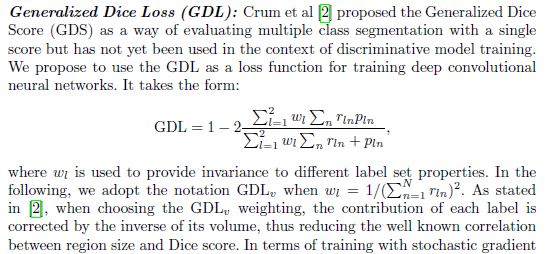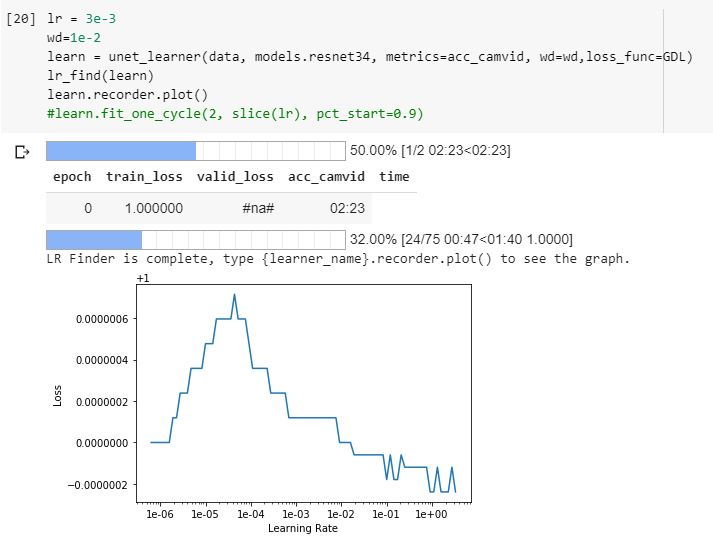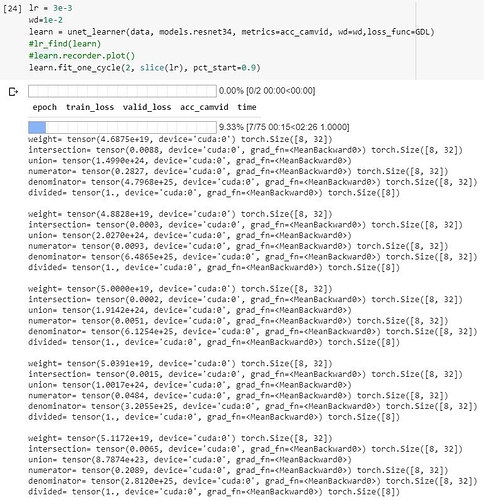Hi there, so I’ve been working on implementing different loss functions for segmentation, partly by adapting work from:
GitHub - LIVIAETS/boundary-loss: Official code for "Boundary loss for highly unbalanced segmentation", runner-up for best paper award at MIDL 2019. Extended version in MedIA, volume 67, January 2021. (work published: [1812.07032] Boundary loss for highly unbalanced segmentation)
Currently I’m just testing things in a colab notebook using the camvid example from part 1 to debug the adaptations.
Loss Function:
def GDL(input, target):
# → Tensor: input = Batch x Classes x Pixels x Pixels, with Classes containing a probability map
for each class. target is classidx encoded
#turn target into one_hot encoding and squeeze
target = class2one_hot(target) # Shape: Batch x Class(one-hot) x 1 x pixels x pixels
target = target.squeeze() # Shape: Batch x Class(one-hot) x pixels x pixels
assert one_hot(target) # asserts fine
#assert simplex(input) #does not assert fine
assert simplex(target) #asserts fine
pc = input.type(torch.float32)
tc = target.type(torch.float32)
w = 1 / ((einsum("bcwh->bc", tc).type(torch.float32) + 1e-10) ** 2) #shape Batch x Classes
print('weight=',w.float().mean(),w.shape)
intersection = w * einsum("bcwh,bcwh->bc", pc, tc) #shape Batch x Classes
print('intersection=',intersection.float().mean(),intersection.shape)
union = w * (einsum("bcwh->bc", pc) + einsum("bcwh->bc", tc)) #shape Batch x Classes
print('union=',union.float().mean())
numerator = (einsum("bc->b", intersection) + 1e-10) #shape Batch x Classes
print('numerator=', numerator.float().mean(),intersection.shape)
denominator = (einsum("bc->b", union) + 1e-10) #shape Batch x Classes
print('denominator=', denominator.float().mean(),union.shape)
divided = 1 - 2 * (numerator / denominator) #Shape Batch
print('divided=',divided.float().mean(),divided.shape)
print('')
loss = divided.mean() #scalar
return loss
Just to clarify, loss functions intake a Batch x Classes x Pixels x Pixels tensor, where classes are probability maps? in this case, target should indeed be one-hot encoded and same shape as input correct?
Loss function equation from paper

Example Lr_find, finding some sort of lr-loss pattern but extremely small values?
Examples of output values and shapes during an epoch
I just feel like its not behaving as it should, producing extremely small numbers? in all cases, the numerator is very small and is divided by a very large number, resulting in 1-(very small number).
In the original code by the authors (in pytorch) (found here: boundary-loss/losses.py at master · LIVIAETS/boundary-loss · GitHub), they assert that input is simplex()=True, which does not work for me, so perhaps my input is different from theirs (custom training loop). The Simplex util is as follows:
def simplex(t, axis=1): #t: tensor-> bool:
_sum = t.sum(axis).type(torch.float32)
_ones = torch.ones_like(_sum, dtype=torch.float32)
return torch.allclose(_sum, _ones)
Which as far as I can tell, checks that in a one-hot encoded tensor, there is only 1 prediction per pixel? this doesnt make sense to me to do on a probability map.


